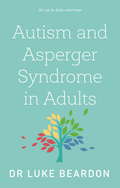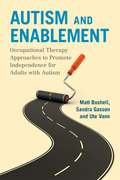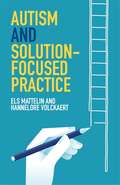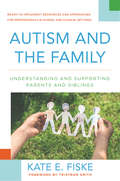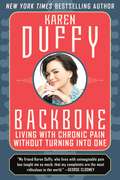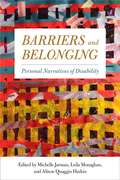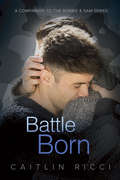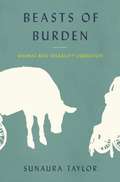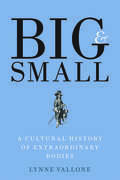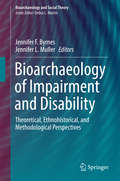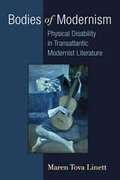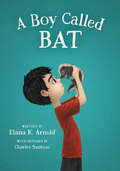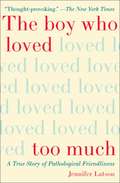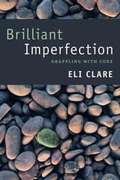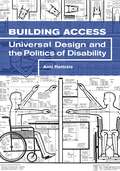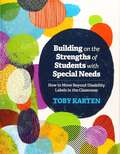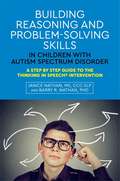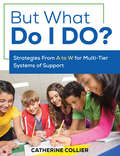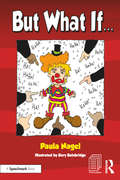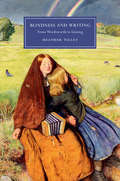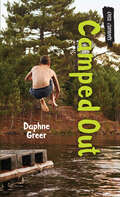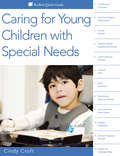- Table View
- List View
Autism and Asperger Syndrome in Adults
by Luke BeardonEstimated to affect just over 1 per cent of the adult population in the UK - some 700,000 individuals ? autism is still persistently viewed as a disorder or impairment ? but, this concept needs to be challenged. Written by a university lecturer with several years? experience in the field, this book presents an up-to-date overview of autism and Asperger syndrome, and comments on the realities of adult life including further and higher education, employment, dating and parenthood. For autistic children, teenagers and adults, their families and friends, and any professionals interested in autism. Topics include:Terminology and what?s preferredCommon myths and stereotypesDiagnosis and related issuesTips for undiagnosed adults Understanding how autism impacts on the individualSensory issuesTransition into adulthoodFriendships and intimate relationshipsThe Criminal Justice System - what happens when autistic people break the lawIn this sensitive and insightful book, Dr Luke Beardon asserts that there are many hugely intelligent, empathic, kind, caring, loyal and skilled autistic individuals ? so it?s time to treat them as such and respect their differences.
Autism and Asperger Syndrome in Adults
by Luke Beardon'Luke has years of valuable experience, and is always thinking and learning about autism' - Professor Nicola MartinHave you recently been diagnosed as autistic?Do you suspect you might be autistic?If you've recently been diagnosed as autistic, think you may be or are close to someone who is, one of the things you will like most about this book is the way in which it challenges the idea of autism as a 'disorder' or 'impairment'.Instead, Dr Luke Beardon will help you to reframe what you feel, and challenge what you know, about being on the spectrum. He explains how autism impacts on the individual, and what purpose a diagnosis might - or might not - serve. There is a lot of myth-busting, and dismantling of the stereotypes and clichés around ASD and areas like communication, social interaction and relationships. Practical tips for undiagnosed adults will help you navigate things like school, work, study, parenthood and even to understand what happens when autistic people break the law.Above all, this book is a celebration of what it means to be autistic - of the passion, honesty, humour, lack of ego, loyalty and trustworthiness that make you, or your loved one, such an amazing person.
Autism and Enablement: Occupational Therapy Approaches to Promote Independence for Adults with Autism
by Matt Bushell Sandra Gasson Ute VannAdults with Autism Spectrum Conditions (ASC) or a suspected diagnosis often have hidden needs that go unmet by public services. This book describes and analyses the Kent ASC enablement approach, a short-term intervention led by occupational therapy to promote people with ASC becoming more self-aware and self-sufficient outside of public services. Designed to teach adults with ASC strategies for controlling their sensory, motor-processing and social-communication needs and preferences, this person-centred approach gives them greater self-management over their lives. The book also provides an overview of a range of both professional and self-help tools and technologies which can be used by adults with ASC to increase independence and wellbeing. Case-studies demonstrate the transformative effects of enablement on daily life for adults with ASC. The book also provides recommendation for building on the enablement approach.
Autism and Solution-focused Practice
by Hannelore Volckaert Els Mattelin Elaine CookTo help clients with autism think differently about their future, practitioners need to think differently about autism... Solution-focused practice is founded on a firm belief that the full potential of every human being can be realized. This concise, pragmatic guide explains how the practice can be effectively adapted to help clients on the autism spectrum find solutions to their problems, by addressing autism not as a disability but as a different way of thinking. The first section is a helpful introduction to how solution-focused practitioners can gain an understanding of autism by viewing it from a 'different culture' perspective; the second part offers handy rules and tips for applying knowledge respectfully and creating successful conversations with clients. People with autism often feel let down by social support services. This forward-thinking book is a vital resource for helping clients feel welcome and empowered in helping settings and beyond.
Autism and the Family: Understanding and Supporting Parents and Siblings
by Kate E. Fiske Tristram SmithReady-to-implement resources and approaches for effective professional care in school and clinical settings. The reverberations of autism spectrum disorders among parents and siblings can be complex. Parents may grapple with the impact of their child's initial diagnosis, wrestle with the tension between their professional ambitions and family obligations, and labor to maintain a healthy union with their partners. Brothers and sisters may be given less attention, asked to assume a more adult role than they feel ready for, or strive for meaningful connection and communication with their sibling and parents. Although the energy of clinicians, teachers, and other professionals working with individuals with autism spectrum disorder is often focused intensively on the child who is diagnosed, the practitioner can also be an invaluable resource for the child's family. Drawing upon clinical research and firsthand family interviews, this book helps clinicians understand the experiences of parents and siblings of a child with ASD from the time of diagnosis through adulthood. It provides clear recommendations for sensitive, informed professional support. Step-by-step in each chapter, Fiske elucidates such vital subjects as: Understanding the experience of diagnosis Recognizing patterns of parent stress over time Appreciating and navigating the effects of ASD on relationships between parents Involving and providing support for siblings Integrating grandparents and other extended family in care and treatment Understanding a family's culture Identifying and developing effective coping strategies Building a strong rapport with parents and family Guiding parents in the treatment of autism And many more, including key takeaways for assisting families in managing feelings of grief and guilt, navigating support options, treatment resources, and related financial concerns, and calibrating the division of labor in the home. Autism and the Family supplies all the foundations necessary for professionals to understand the full impact of ASD on the child, siblings, and parents and cultivate an empathic, supportive approach to treatment for the entire family.
Autism Spectrum Disorders: Foundations, Characteristics, and Effective Strategies
by E. Boutot Brenda MylesAutism Spectrum Disorders provides teachers of students with Autism Spectrum Disorder (ASD) or other developmental disabilities with important background information, historical context, etiological underpinnings, and characteristics of ASD that may impact learning. Written in an easy-to-follow format, the book focuses on evidence-based practices and approaches that have empirical bases for use. The book identifies current trends in research and practice and includes special Research, Diversity, and Trends and Issues boxes to clarify the concepts. Each chapter begins with real life scenarios depicting key information and concepts found in that chapter and include key terms, chapter objectives, end-of-chapter questions, and web resources to enhance learning and expand beyond the text. Significant changes to this edition include a chapter focusing on play, a chapter on motor development, and a chapter on sexuality. Updates and changes to the functional academics, functional life skills, environmental supports, and transition chapters add currency and further clarification to those topics. Throughout, the book focuses on real world practice that promotes lifespan success.
Backbone: Living with Chronic Pain without Turning into One
by Karen DuffyAn inspirational, powerful, and funny manual for coping and living with devastating pain. For two decades, Karen Duffy —New York Times bestselling author, former MTV VJ, Revlon model, and actress— has managed to live an enriching life despite living in a state of constant pain. Duffy has sarcoidosis, a disorder that causes the growth of inflammatory cells on different organs of the body. In her case, her sarcoidosis is located in her brain, causing her unimaginable pain. In this powerful, inspirational, funny, and important manual for surviving pain, Duffy draws on her experience as a patient advocate, certified recreational therapist, and hospital chaplain to illuminate gratifying methods people can use to cope with chronic pain and reinforces the sentiment that "circumstances determine our lives, but we shape our lives by what we make of circumstances" (Sir John Wheeler Bennet). More than one-third of the US population—nearly 113 million Americans—is currently living with chronic pain, while another 133 million Americans live with some form of chronic illness. Half of the US population lives with the challenges of these invisible illnesses where their symptoms are not always obvious to the casual observer. Addressing a country ravaged by both chronic pain and opioid addiction, Backbone offers a salve of self-sufficiency, spunk, and perseverance. With a light tone, deft wordplay, and interactive gems such as the Bill Murray Pain Scale, Mastectomy Paper Dolls, and a crown to wear just for getting out of bed, Duffy's serious—and seriously funny—book is for the massive population living with chronic pain who are eager to be understood and helped, and sends the message that despite the pain, there is a way to a good life.
Barriers and Belonging: Personal Narratives of Disability
by Alison Quaggin Harkin Leila Monaghan Michelle JarmanWhat is the direct impact that disability studies has on the lives of disabled people today? The editors and contributors to this essential anthology, Barriers and Belonging, provide thirty-seven personal narratives thatexplore what it means to be disabled and why the field of disability studies matters. The editors frame the volume by introducing foundational themes of disability studies. They provide a context of how institutions—including the family, schools, government, and disability peer organizations—shape and transform ideas about disability. They explore how disability informs personal identity, interpersonal and community relationships, and political commitments. In addition, there are heartfelt reflections on living with mobility disabilities, blindness, deafness, pain, autism, psychological disabilities, and other issues. Other essays articulate activist and pride orientations toward disability, demonstrating the importance of reframing traditional narratives of sorrow and medicalization. The critical, self-reflective essays in Barriers and Belonging provide unique insights into the range and complexity of disability experience.
Battle Born (Robbie & Sam)
by Caitlin RicciA Companion to the Robbie & Sam SeriesDaniel Messana wanted a way out of Thornwood, Colorado, and he found it in the Army. Now he’s returned with no more direction to his life than he had when he left as an angry teenager. And even though the war is behind him, the things he experienced won’t leave him in peace. His PTSD plagues him in crowds, and isolation sets in when he’s by himself. Because of the way he treated his brothers, regret gnaws at him, and he has no family to turn to. For Franklin “Coop” Cooper, the Army was life, and one he loved. But when an IED in Afghanistan left him blind, it ended not only the career he’d built, but any chance of being his own man. Back home, his parents refuse to let him do anything for himself, even though Coop and his service dog are ready to move forward and adjust to his new conditions. His only escape from being coddled like a child is going for pizza on base while his mother shops on Fridays. There, Daniel sits down next to him, and the two men begin a friendship that could become more—if they can break free from everything holding them back.
Beasts of Burden: Animal and Disability Liberation
by Sunaura TaylorA deeply provocative inquiry into the intersection of animal and disability liberation and the debut of an important new social critic How much of what we understand of ourselves as "human" depends on our physical and mental abilities how we move (or cannot move) in and interact with the world? And how much of our definition of "human" depends on its difference from "animal"? Drawing on her own experiences as a disabled person, a disability activist, and an animal advocate, author Sunaura Taylor persuades us to think deeply, and sometimes uncomfortably, about what divides the human from the animal, the disabled from the non-disabled and what it might mean to break down those divisions, to claim the animal and the vulnerable in ourselves, in a process she calls "cripping animal ethics." Beasts of Burden suggests that issues of disability and animal justice which have heretofore primarily been presented in opposition are in fact deeply entangled. Fusing philosophy, memoir, science, and the radical truths these disciplines can bring whether about factory farming, disability oppression, or our assumptions of human superiority over animals Taylor draws attention to new worlds of experience and empathy that can open up important avenues of solidarity across species and ability. Beasts of Burden is a wonderfully engaging and elegantly written work, both philosophical and personal, by a brilliant new voice.
Big and Small: A Cultural History of Extraordinary Bodies
by Lynne ValloneA groundbreaking work that explores human size as a distinctive cultural marker in Western thought Author, scholar, and editor Lynne Vallone has an international reputation in the field of child studies. In this analytical tour-de-force, she explores bodily size difference—particularly unusual bodies, big and small—as an overlooked yet crucial marker that informs human identity and culture. Exploring miniaturism, giganticism, obesity, and the lived experiences of actual big and small people, Vallone boldly addresses the uncomfortable implications of using physical measures to judge normalcy, goodness, gender identity, and beauty. This wide-ranging work surveys the lives and contexts of both real and imagined persons with extraordinary bodies from the seventeenth century to the present day through close examinations of art, literature, folklore, and cultural practices, as well as scientific and pseudo-scientific discourses. Generously illustrated and written in a lively and accessible style, Vallone’s provocative study encourages readers to look with care at extraordinary bodies and the cultures that created, depicted, loved, and dominated them.
Bioarchaeology of Impairment and Disability: Theoretical, Ethnohistorical, and Methodological Perspectives (Bioarchaeology and Social Theory)
by Jennifer F. Byrnes Jennifer L. MullerOver the years, impairment has been discussed in bioarchaeology, with some scholars providing carefully contextualized explanations for their causes and consequences. Such investigations typically take a case study approach and focus on the functional aspects of impairments. However, these interpretations are disconnected from disability theory discourse. Other social sciences and the humanities have far surpassed most of anthropology (with the exception of medical anthropology) in their integration of social theories of disability. This volume has three goals: The first goal of this edited volume is to present theoretical and methodological discussions on impairment and disability. The second goal of this volume is to emphasize the necessity of interdisciplinarity in discussions of impairment and disability within bioarchaeology. The third goal of the volume is to present various methodological approaches to quantifying impairment in skeletonized and mummified remains.
Bodies of Modernism: Physical Disability in Transatlantic Modernist Literature
by Maren LinettBodies of Modernism brings a new and exciting analytical lens to modernist literature, that of critical disability studies. The book offers new readings of canonical and noncanonical writers from both sides of the Atlantic including Flannery O'Connor, Eudora Welty, H. G. Wells, D. H. Lawrence, Elizabeth Bowen, Henry Green, Olive Moore, Carson McCullers, Tennessee Williams, J. M. Synge, Florence Barclay, Virginia Woolf, and James Joyce. Through readings of this wide range of texts and with chapters focusing on mobility impairments, deafness, blindness, and deformity, the study reveals both modernism's skepticism about and dependence on fantasies of whole, "normal" bodies.
A Boy Called Bat (The Bat Series #1)
by Charles Santoso Elana K. ArnoldFrom acclaimed author Elana K. Arnold and with illustrations by Charles Santoso, A Boy Called Bat is the first book in a funny, heartfelt, and irresistible young middle grade series starring an unforgettable young boy on the autism spectrum.For Bixby Alexander Tam (nicknamed Bat), life tends to be full of surprises—some of them good, some not so good. Today, though, is a good-surprise day. Bat’s mom, a veterinarian, has brought home a baby skunk, which she needs to take care of until she can hand him over to a wild-animal shelter.But the minute Bat meets the kit, he knows they belong together. And he’s got one month to show his mom that a baby skunk might just make a pretty terrific pet.
The Boy Who Loved Too Much: A True Story of Pathological Friendliness
by Jennifer LatsonThe poignant story of a boy’s coming-of-age complicated by Williams syndrome, a genetic disorder that makes people biologically incapable of distrust.What would it be like to see everyone as a friend? Twelve-year-old Eli D’Angelo has a genetic disorder that obliterates social inhibitions, making him irrepressibly friendly, indiscriminately trusting, and unconditionally loving toward everyone he meets. It also makes him enormously vulnerable. Eli lacks the innate skepticism that will help his peers navigate adolescence more safely—and vastly more successfully. Journalist Jennifer Latson follows Eli over three critical years of his life as his mother, Gayle, must decide whether to shield Eli entirely from the world and its dangers or give him the freedom to find his own way and become his own person. By intertwining Eli and Gayle’s story with the science and history of Williams syndrome, the book explores the genetic basis of behavior and the quirks of human nature. More than a case study of a rare disorder, however, The Boy Who Loved Too Much is a universal tale about the joys and struggles of raising a child, of growing up, and of being different.
Brilliant Imperfection: Grappling with Cure
by Eli ClareIn Brilliant Imperfection Eli Clare uses memoir, history, and critical analysis to explore cure—the deeply held belief that body-minds considered broken need to be fixed. Cure serves many purposes. It saves lives, manipulates lives, and prioritizes some lives over others. It provides comfort, makes profits, justifies violence, and promises resolution to body-mind loss. Clare grapples with this knot of contradictions, maintaining that neither an anti-cure politics nor a pro-cure worldview can account for the messy, complex relationships we have with our body-minds. The stories he tells range widely, stretching from disability stereotypes to weight loss surgery, gender transition to skin lightening creams. At each turn, Clare weaves race, disability, sexuality, class, and gender together, insisting on the nonnegotiable value of body-mind difference. Into this mix, he adds environmental politics, thinking about ecosystem loss and restoration as a way of delving more deeply into cure. Ultimately Brilliant Imperfection reveals cure to be an ideology grounded in the twin notions of normal and natural, slippery and powerful, necessary and damaging all at the same time.
Building Access: Universal Design and the Politics of Disability
by Aimi Hamraie“All too often,” wrote disabled architect Ronald Mace, “designers don’t take the needs of disabled and elderly people into account.” Building Access investigates twentieth-century strategies for designing the world with disability in mind. Commonly understood in terms of curb cuts, automatic doors, Braille signs, and flexible kitchens, Universal Design purported to create a built environment for everyone, not only the average citizen. But who counts as “everyone,” Aimi Hamraie asks, and how can designers know? Blending technoscience studies and design history with critical disability, race, and feminist theories, Building Access interrogates the historical, cultural, and theoretical contexts for these questions, offering a groundbreaking critical history of Universal Design. Hamraie reveals that the twentieth-century shift from “design for the average” to “design for all” took place through liberal political, economic, and scientific structures concerned with defining the disabled user and designing in its name. Tracing the co-evolution of accessible design for disabled veterans, a radical disability maker movement, disability rights law, and strategies for diversifying the architecture profession, Hamraie shows that Universal Design was not just an approach to creating new products or spaces, but also a sustained, understated activist movement challenging dominant understandings of disability in architecture, medicine, and society.Illustrated with a wealth of rare archival materials, Building Access brings together scientific, social, and political histories in what is not only the pioneering critical account of Universal Design but also a deep engagement with the politics of knowing, making, and belonging in twentieth-century United States.
Building on the Strengths of Students with Special Needs: How to Move Beyond Disability Labels in the Classroom
by Toby KartenAs a must-have reference for busy teachers with little special education training, this book supplies classroom-tested instructional strategies that address the characteristics of and challenges faced by students with special needs. Dozens of differentiated strategies target teachers’ anxieties and provide responsive interventions that can be used to address specifics of IEPs and learning plans. <p><p>With Building on the Strengths of Students with Special Needs, special education expert Toby Karten focuses on specific disabilities and inclusive curriculum scenarios for learners in K–12 environments. She offers valuable advice on how to prevent labels from capping student potential and encouragement to help teachers continually improve learner outcomes. <p><p>By highlighting more than a dozen disability labels, this resource walks teachers through the process of reinforcing, motivating, scaffolding, and planning for instruction that targets learners of all ability levels. Included are details relevant to each disability: <p>•Possible Causes <p>•Characteristics and Strengths <p>•Classroom Implications <p>•Inclusion Strategies <p><p>Typical instruction needs to match the diversity of atypical learners without viewing any disability as a barrier that impedes student achievement. Teachers must not only learn how to differentiate their approach and target specific student strengths but also maintain a positive attitude and belief that all students are capable of achieving self-efficacy.
Building Reasoning and Problem-Solving Skills in Children with Autism Spectrum Disorder: A Step by Step Guide to the Thinking In Speech® Intervention
by Janice NathanTeaching children with Autism Spectrum Disorder (ASD) to develop the 'inner voice' needed to solve problems, this book's innovative approach will help children reach logical and appropriate solutions to everyday problems. This book shows students and professionals how to formally teach key skills for reasoning and problem-solving that aren't usually explicitly taught, such as planning, pausing and reflecting and increasing emotional regulation. Focusing on the 'inner voice' - the dialogue that goes on inside our heads during every day routines - the authors explain how to help children with ASD solve problems independently. The book also shows how children can learn to cope with feelings of stress when confronted with difficult situations, whether getting stuck on homework, making mistakes, choosing options, following procedures that are perceived to be arbitrary, or everyday social situations. Examples of implementing this new approach in different situations are given to show the many ways of teaching these cognitive skills to children with autism.
But What Do I DO?: Strategies From A to W for Multi-Tier Systems of Support
by Catherine C. CollierIdentifying appropriate strategies for instruction or intervention made easy! Select individualized and evidence-based interventions for struggling students with this comprehensive guide. Organized around an alphabetized and cross-referenced list and a fold-out selection grid featuring more than 150 PBIS, RTI and MTSS interventions, you’ll quickly find the tools to resolve specific learning and behavioral challenges. You’ll learn to Meet the needs of all your struggling students including at-risk, culturally and linguistically diverse, as well as those with IEPs Progress monitor, document, and modify instructional strategies Identify specific interventions for distinct learning and behavior problems Implement in variety of settings, including special education, learning assistance programs, and full-inclusion
But What Do I DO?: Strategies From A to W for Multi-Tier Systems of Support
by Catherine C. CollierIdentifying appropriate strategies for instruction or intervention made easy! Select individualized and evidence-based interventions for struggling students with this comprehensive guide. Organized around an alphabetized and cross-referenced list and a fold-out selection grid featuring more than 150 PBIS, RTI and MTSS interventions, you’ll quickly find the tools to resolve specific learning and behavioral challenges. You’ll learn to Meet the needs of all your struggling students including at-risk, culturally and linguistically diverse, as well as those with IEPs Progress monitor, document, and modify instructional strategies Identify specific interventions for distinct learning and behavior problems Implement in variety of settings, including special education, learning assistance programs, and full-inclusion
But What If: But What If...; Mind Reading; Stuck On A Loop; Waht Is It? (Rollercoaster Series)
by Paula NagelThis is a focus on worries about transition to secondary school. Jake is in Year 6. He is worried about the transition to secondary school because he has heard many rumours, including one about the older pupils flushing first years' heads down the toilets. The story illustrates how many of the pupils share similar worries about the impending transition even though their behavior looks different. Jake's behaviour illustrates his initial negative coping strategies as his worry grows. This includes not talking about it, opting out of his usual interests and activities, not sleeping and becoming angry with his mother. Some of his worries are alleviated on his taster visit to the new school, especially when he plucks up the courage to go into the boys' toilets. Following a misunderstanding in the toilets with some older boys, he is able to share his worries with another pupil and use humour to reflect on his behaviour. The accompanying, 'Let's talk about .worry,' text shares information and facts about mental health and transition. Paul Nagel has worked as an educational psychologist for 17 years. This has included working as a Lead Professional Educational Psychologist managing a traded service, as well as holding Senior Specialist posts for early years and disability. Over the years Paula has worked in multi agency teams within paediatric services, youth offending teams, Sure Start and an anti bullying service. She is currently Principal Educational Psychologist (North) for the national children's mental health charity, Place2Be. Before qualifying as an Educational Psychologist Paula was a primary school teacher. Gary Bainbridge is an artist, comics creator and secondary school Art, Photography and Media Studies teacher from Durham. He's best known for the North East based kitchen sink superhero comic Sugar Glider and the Newcastle-set crime fiction comic, Nightbus. Gary teaches at an academy in Northumberland.
Cambridge Studies in Nineteenth-Century Literature and Culture: From Wordsworth to Gissing (Cambridge Studies in Nineteenth-Century Literature and Culture #109)
by Heather Tilley<P>In this innovative and important study, Heather Tilley examines the huge shifts that took place in the experience and conceptualisation of blindness during the nineteenth century, and demonstrates how new writing technologies for blind people had transformative effects on literary culture. <P>Considering the ways in which visually-impaired people used textual means to shape their own identities, the book argues that blindness was also a significant trope through which writers reflected on the act of crafting literary form. <P>Supported by an illuminating range of archival material (including unpublished letters from Wordsworth's circle, early ophthalmologic texts, embossed books, and autobiographies) this is a rich account of blind people's experience, and reveals the close, and often surprising personal engagement that canonical writers had with visual impairment. <P>Drawing on the insights of disability studies and cultural phenomenology, Tilley highlights the importance of attending to embodied experience in the production and consumption of texts.
Camped Out (Orca Currents)
by Daphne GreerMax knows his mom can't afford to send him to summer camp. But he really, really wants to go. He needs a break from looking after his autistic brother, Duncan. And from his mom's new boyfriend. He is surprised when his mom says that he can go after all. But there's a catch. There are spots available at the camp for families with special needs. A grant would cover Duncan's fees, and Max could attend at no charge. If he goes as Duncan's escort. This is the second story featuring Max and Duncan after Maxed Out.
Caring for Young Children with Special Needs
by Cindy CroftThis easy-to-use guide gives you a quick overview on many topics related to working with young children with special needs. Learn about inclusion in early childhood programs and disability law, as well as typical vs. atypical development. The quick guide also covers several specific disabilities/special needs and provides definitions, common characteristics, and practical strategies for adaptation.Cindy Croft is the director of the Center for Inclusive Child Care at Concordia University and on faculty for several university education programs. She has her MA in Education and has worked in the field of early childhood for over twenty years.
